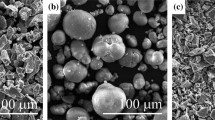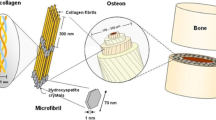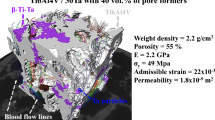Abstract
The central goal of this initial effort is to develop and characterize distinctive piezo-biocomposites as load-bearing orthopedic implants. The motivation is derived from the fact that mammalian bone is a piezoelectric material and this property is helpful in the natural healing of fractured bone. We have employed a cost-effective and industrially viable technique—conventional sintering to consolidate specific compositions of hydroxyapatite (HA) and barium titanate (BT). HA is the primary mineral constituent of mammalian bone but is not piezoelectric. On the contrary, BT is well known for its piezoelectric properties. Their combination creates piezo-biocomposites. The sintering is reactive in nature as BT decomposes into several compounds. Average grain sizes of piezo-biocomposites lie in the range of 1.75–1.9 µm. Interestingly, 15% compressive strength enhancement is noted in the case of HA-40 wt% BT as compared to HA. In vitro examinations reveal favorable bioactivity and biocompatible nature of the composites. These results show that conventionally sintered HA-BT piezo-biocomposites can qualify as candidate materials for load-bearing implants at affordable prices.







Similar content being viewed by others
References
Simon J, and Simon B, Electrical bone stimulation. In Musculoskeletal Tissue Regeneration Human Press (2008) 259.
Carrodeguas R G, V’ zquez B, del Barrio J S R, and de la Cal A M, Int J Polym Mater 51 (2002) 591.
Fukada E, and Yasuda I, J Phys Soc Jpn 12 (1957) 1158.
Fukada E, and Yasuda I, Jpn J Appl Phys 3 (1964) 117.
Bassett C A L, and Becker R O, Science 137 (1962) 1063.
Bassett C A L, Sci Am 213 (1965) 18.
Fredericks D C, Smucker J, Petersen E B, Bobst J A, Gan J C, Simon B J, and Glazer P, Spine 32 (2007) 174.
Dubey A K, EA A, Balani K, and Basu B, J Am Ceram Soc 96 (2013) 3753.
Akao M, Aoki H, and Kato K, J Mater Sci 16 (1981) 809.
Bellucci D, Desogus L, Montinaro S, Orrù R, Cao G, and Cannillo V, J Eur Ceram Soc 37 (2017) 1723.
Karimzadeh A, Ayatollahi M R, Bushroa A R, and Herliansyah M K, Ceram Int 40 (2014) 9159.
Park J B, Von Recum A F, Kenner G H, Kelly B J, Coffeen W W, and Grether M F, J Biomed Mater Res Part A 14 (1980) 269.
Jianqing F, Huipin Y, and Xingdong Z, Biomaterials 18 (1997) 1531.
Park J B, Kelly B J, Kenner G H, Von Recum A F, Grether M F, and Coffeen W W, J Biomed Mater Res Part A 15 (1981) 103.
Nacer R S, Silva B A K D, Poppi R R, Silva D K M, Cardoso V S, Delben J R J, and Delben A A S T, Acta Cir Bras 30 (2015) 255.
Dubey A K, Thrivikraman G, and Basu B, J Mater Sci Mater Med 26 (2015) 1.
Dubey A K, and Basu B, J Am Ceram Soc 97 (2014) 481.
Grether M F, Coffeen W W, Kenner G H, and Park J B, Biomater Med Devices Artif Organs 8 (1980) 265.
Park Y J, Hwang K S, Song J E, Ong J L, and Rawls H R, Biomaterials 23 (2002) 3859.
Ciofani G, Ricotti L, Canale C, D’Alessandro D, Berrettini S, Mazzolai B, and Mattol, V, Coll Surf B Biointerfaces 102 (2013) 312.
Ciofani G, Danti S, D’Alessandro D, Moscato S, Petrini M, and Menciassi A, Nanoscale Res Lett 5 (2010) 1093.
Dubey A K, and Kakimoto K I, Mater Sci Eng C 63 (2016) 211.
Mallik P K, and Basu B, J Biomed Mater Res Part A 102 (2014) 842.
Thrivikraman G, Mallik P K, and Basu B, Biomaterials 34 (2013) 7073.
Ravikumar K, Mallik P K, and Basu B, J Eur Ceram Soc 36 (2016) 805.
Prakasam M, Albino M, Lebraud E, Maglione M, Elissalde C, and Largeteau A, J Am Ceram Soc 100 (2017) 2621.
Koju N, Sikder P, Gaihre B, and Bhaduri S B, Materials 11 (2018) 1258.
Ruys A J, Wei M, Sorrell C C, Dickson M R, Brandwood A, and Milthorpe B K, Biomaterials 16 (1995) 409.
Champion E, Acta Biomater 9 (2013) 5855.
Sikder P, Sarkar S, Biswas KG, Das S, Basu S, and Das PK, Mater Chem Phys 170 (2016) 99.
Sikder P, Pramanick A, Sarkar S, Das S, Dey P P, and Das P K. Adv Appl Ceram 114 (2015) 448.
Boroujeni N M, Zhou H, Luchini T J F, and Bhaduri S B, J Biomed Mater Res Part B 102 (2014) 260.
Spiegler R, Schmauder S, and Sigl L S, J Hard Mater 1 (1990) 147.
Jalota S, Bhaduri S B, and Tas A C, J Mater Sci Mater Med 17 (2006) 697.
Sikder P, Koju N, Ren Y, Goel V K, Phares T, Lin B, and Bhaduri S B, Surf Coat Technol 342 (2018) 342.
Zhou H, Luchini T J F, Boroujeni N M, Agarwal A K, Goel V K, and Bhaduri S B, Mater Sci Eng C 50 (2015) 45.
Sikder P, Grice C R, Lin B, Goel V K, and Bhaduri S B, ACS Biomater Sci Eng 4 (2018) 2767.
Rehman I, and Bonfield W, J Mater Sci Mater Med 8 (1997) 1.
Sikder P, and Bhaduri S B, J Am Ceram Soc 101 (2018) 2537.
Koju N, Sikder P, Ren Y, Zhou H, and Bhaduri S B, Curr Opin Chem Eng 15 (2017) 49.
Monmaturapoj N, and Yatongchai C, J Metals Mater Miner 20 (2017).
Dubey A K, Mallik P K, Kundu S, and Basu B, J Eur Ceram Soc 33 (2013) 3445.
Ren Y, Sikder P, Lin B, and Bhaduri S B, Mater Sci Eng C 85 (2018) 107.
Baxter F R, Turner I G, Bowen C R, Gittings J P, and Chaudhuri J B, J Mater Sci Mater Med 20 (2009) 1697.
Acknowledgements
SBB is humbled by being able to contribute to this issue in honor of Prof. E. C. Subbarao. He has many fond memories of interactions during many trips that occurred between DMRL, Hyderabad, and TRDDC, Pune, between years 1983 and 1989. This work was supported by the NSF Grant No. 1706513.
Author information
Authors and Affiliations
Corresponding author
Rights and permissions
About this article
Cite this article
Sikder, P., Koju, N., Lin, B. et al. Conventionally Sintered Hydroxyapatite–Barium Titanate Piezo-Biocomposites. Trans Indian Inst Met 72, 2011–2018 (2019). https://doi.org/10.1007/s12666-018-1533-3
Received:
Accepted:
Published:
Issue Date:
DOI: https://doi.org/10.1007/s12666-018-1533-3




